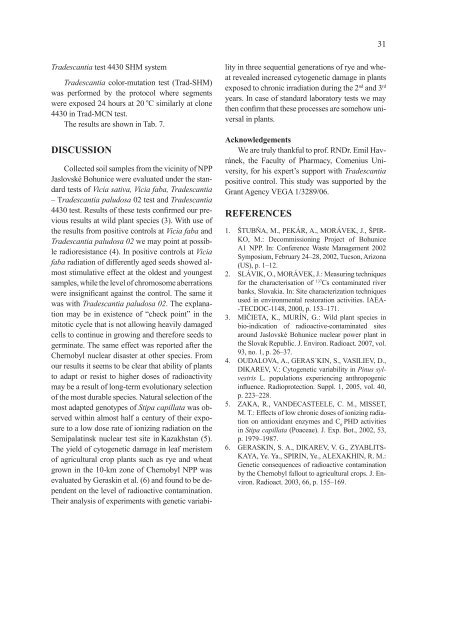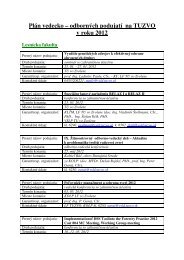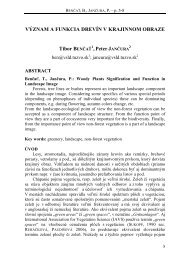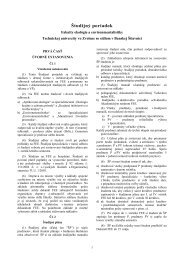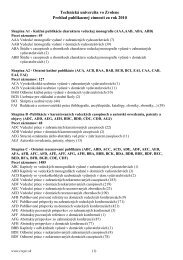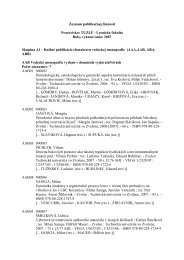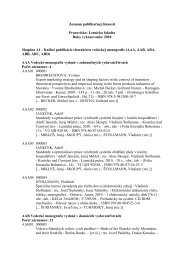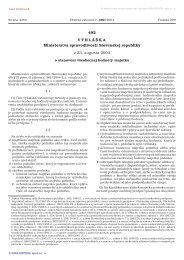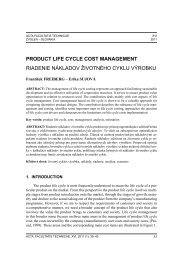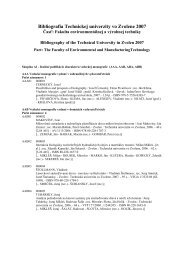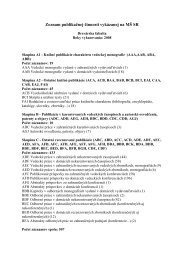Acta Facultatis Ecologiae - Technická univerzita vo Zvolene
Acta Facultatis Ecologiae - Technická univerzita vo Zvolene
Acta Facultatis Ecologiae - Technická univerzita vo Zvolene
- No tags were found...
Create successful ePaper yourself
Turn your PDF publications into a flip-book with our unique Google optimized e-Paper software.
31Tradescantia test 4430 SHM systemTradescantia color-mutation test (Trad-SHM)was performed by the protocol where segmentswere exposed 24 hours at 20 o C similarly at clone4430 in Trad-MCN test.The results are shown in Tab. 7.DISCUSSIONCollected soil samples from the vicinity of NPPJaslovské Bohunice were evaluated under the standardtests of Vicia sativa, Vicia faba, Tradescantia– Tradescantia paludosa 02 test and Tradescantia4430 test. Results of these tests confirmed our previousresults at wild plant species (3). With use ofthe results from positive controls at Vicia faba andTradescantia paludosa 02 we may point at possibleradioresistance (4). In positive controls at Viciafaba radiation of differently aged seeds showed almoststimulative effect at the oldest and youngestsamples, while the level of chromosome aberrationswere insignificant against the control. The same itwas with Tradescantia paludosa 02. The explanationmay be in existence of “check point” in themitotic cycle that is not allowing heavily damagedcells to continue in growing and therefore seeds togerminate. The same effect was reported after theChernobyl nuclear disaster at other species. Fromour results it seems to be clear that ability of plantsto adapt or resist to higher doses of radioactivitymay be a result of long-term e<strong>vo</strong>lutionary selectionof the most durable species. Natural selection of themost adapted genotypes of Stipa capillata was observedwithin almost half a century of their exposureto a low dose rate of ionizing radiation on theSemipalatinsk nuclear test site in Kazakhstan (5).The yield of cytogenetic damage in leaf meristemof agricultural crop plants such as rye and wheatgrown in the 10-km zone of Chernobyl NPP wasevaluated by Geraskin et al. (6) and found to be dependenton the level of radioactive contamination.Their analysis of experiments with genetic variabilityin three sequential generations of rye and wheatrevealed increased cytogenetic damage in plantsexposed to chronic irradiation during the 2 nd and 3 rdyears. In case of standard laboratory tests we maythen confirm that these processes are somehow universalin plants.AcknowledgementsWe are truly thankful to prof. RNDr. Emil Havránek,the Faculty of Pharmacy, Comenius University,for his expert’s support with Tradescantiapositive control. This study was supported by theGrant Agency VEGA 1/3289/06.REFERENCES1. ŠTUBŇA, M., PEKÁR, A., MORÁVEK, J., ŠPIR-KO, M.: Decommissioning Project of BohuniceA1 NPP. In: Conference Waste Management 2002Symposium, February 24–28, 2002, Tucson, Arizona(US), p. 1–12.2. SLÁVIK, O., MORÁVEK, J.: Measuring techniquesfor the characterisation of 137 Cs contaminated riverbanks, Slovakia. In: Site characterization techniquesused in environmental restoration activities. IAEA--TECDOC-1148, 2000, p. 153–171.3. MIČIETA, K., MURÍN, G.: Wild plant species inbio-indication of radioactive-contaminated sitesaround Jaslovské Bohunice nuclear power plant inthe Slovak Republic. J. Environ. Radioact. 2007, <strong>vo</strong>l.93, no. 1, p. 26–37.4. OUDALOVA, A., GERAS´KIN, S., VASILIEV, D.,DIKAREV, V.: Cytogenetic variability in Pinus sylvestrisL. populations experiencing anthropogenicinfluence. Radioprotection. Suppl. 1, 2005, <strong>vo</strong>l. 40,p. 223–228.5. ZAKA, R., VANDECASTEELE, C. M., MISSET,M. T.: Effects of low chronic doses of ionizing radiationon antioxidant enzymes and C 6PHD activitiesin Stipa capillata (Poaceae). J. Exp. Bot., 2002, 53,p. 1979–1987.6. GERASKIN, S. A., DIKAREV, V. G., ZYABLITS-KAYA, Ye. Ya., SPIRIN, Ye., ALEXAKHIN, R. M.:Genetic consequences of radioactive contaminationby the Chernobyl fallout to agricultural crops. J. Environ.Radioact. 2003, 66, p. 155–169.


